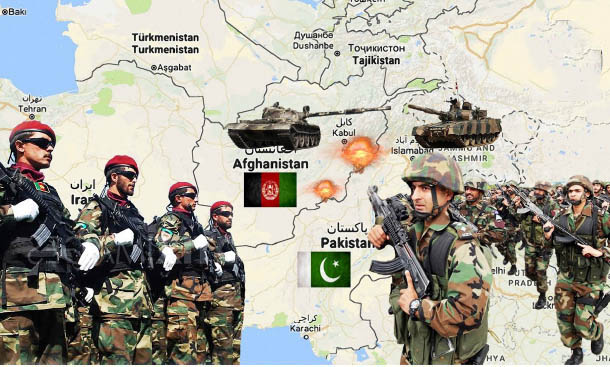The Pakistan Afghanistan border clash erupted, leaving 200+ soldiers dead. GeoInflux analyzes the causes, conflicting casualty reports, and India’s diplomatic role in reshaping the regional balance.
What Sparked the Latest Pakistan Afghanistan Border Clash?
The border dividing Pakistan and Afghanistan, known as the Durand Line, has always been a fault line of historical disputes and volatility.
But the recent full-scale military engagements between Pakistani forces and Afghan Taliban fighters mark an alarming escalation.
For several days, intense shelling, air operations, and troop movements turned this rugged frontier into a Pakistan Afghanistan Border clash.
Yet, what truly defines this crisis isn’t just the violence itself—it’s the clashing narratives and the shifting geopolitics swirling around it, shaped by India’s quietly assertive diplomacy.
At the center of the confusion are wildly conflicting casualty claims.
Pakistan claims to have killed over 200 Afghan fighters while losing only 23 of its own. Kabul counters this, saying as many as 58 Pakistani soldiers were killed, with minimal Afghan losses.
This report analyzes the competing versions, separates propaganda from reality, and explores how India–Taliban diplomacy may have fundamentally altered the balance of power in the region.
What Really Happened on the Ground Along the Durand Line?
The latest clashes along the Durand Line weren’t the usual low-intensity exchanges. Afghan fighters launched coordinated assaults on multiple Pakistani outposts, reportedly overwhelming some positions and forcing chaotic retreats.
Eyewitness accounts suggest Pakistan had to deploy helicopter gunships and heavy artillery, while Afghan forces used drones and anti-air assets, signaling a planned and well-resourced offensive.
Why Global Analysts Doubt Pakistan’s Claims
Pakistan’s claim of 200 Afghan casualties has drawn widespread skepticism. Analysts across defense forums in the US, China, and Europe have highlighted three key reasons for doubt:
- Lack of Evidence – Pakistan hasn’t produced any verifiable images or proof to back the casualty count.
- Afghan Transparency (Relative) – The Taliban released multiple combat videos showing Pakistani outposts being overrun and soldiers retreating.
- Tactical Surprise – Afghan forces initiated the assault, giving them an early advantage against Pakistan’s scattered, defensive positions.
Independent observers conclude the clash resulted in a significant morale setback for Pakistan’s military, regardless of exact numbers.
How Did India’s Diplomacy Shift the Regional Balance?
While the Durand Line burned, a different kind of battle was being waged in New Delhi’s corridors of power.
Just days before the escalation, Taliban Foreign Minister Amir Khan Muttaqi completed a seven-day, high-profile visit to India—a landmark event signaling a quiet thaw between New Delhi and Kabul.
India’s Strategic Re-Engagement
During the visit, India made several pivotal moves:
- Embassy Reopening: Announced plans to fully reopen its mission in Kabul.
- Infrastructure Revival: Committed to restarting key development projects halted since 2021.
- Mineral Cooperation: Accepted Afghanistan’s invitation to explore its vast mineral resources.
These gestures mark a diplomatic re-entry into Afghanistan—one that bypasses Pakistan entirely.
The Kashmir Declaration Shock
The diplomatic bombshell came when Muttaqi, speaking in New Delhi, affirmed publicly that Jammu and Kashmir is an integral part of India.
This was unprecedented. Never before has an Afghan representative made such a statement.
Islamabad reacted with fury, calling it a “clear violation of international law.”
For New Delhi, it was a diplomatic masterstroke: isolating Pakistan on its core issue and flipping decades of alignment between Kabul and Islamabad.
Why Is Pakistan Facing a Two-Front (and Possibly Three-Front) Crisis?
The fallout from the border clashes and India–Taliban rapprochement has created a nightmare for Islamabad—a Pakistan Two-Front War scenario.
- Eastern Front: Persistent tensions with India.
- Western Front: Hostility with an increasingly defiant Taliban.
- Internal Front: Political, economic, and social instability.
The ‘Operation Sindoor Part 2’ Theory
Global defense analysts speculate that India’s diplomatic timing wasn’t coincidental. Many suggest it mirrors past Indian strategies, collectively nicknamed “Operation Sindoor.”
While there’s no evidence of Indian military involvement, the perception that India’s diplomacy emboldened the Taliban is widespread. That perception alone has reshaped regional alignments.
Saudi Arabia’s Silent Withdrawal
Adding insult to injury, Pakistan’s recent Saudi defense pact failed to deliver.
Riyadh and Doha—once touted as Islamabad’s backers—chose neutral mediation instead of support.
The absence of Saudi commitment exposed the pact as more symbolic than strategic, deepening Pakistan’s sense of isolation.
What Are the Strategic Implications for South Asia?
The latest border violence signals a new and dangerous phase in the Durand Line conflict. Skirmishes that once involved dozens of casualties now risk spiraling into full-scale confrontations.
India’s Expanding Strategic Window
India’s engagement with the Taliban opens a rare opportunity:
- Pakistan’s alliances are weakening.
- Its economy is collapsing.
- Its military morale is faltering on two fronts.
By maintaining quiet pressure and deepening economic ties with Kabul, New Delhi can reshape South Asia’s power geometry without direct confrontation.
The geopolitical message is unmistakable:
Pakistan’s era of regional dominance is ending.
India is leveraging diplomacy, not missiles, to redraw the map of influence.
What Are the 4 Key Takeaways from the Pakistan Afghanistan Border Clash?
| Element | Summary of Shift | Impact on Pakistan |
|---|---|---|
| Border Conflict | Escalated from small skirmishes to organized military confrontations. | Heavy troop losses and rising pressure along the western border. |
| Casualty Claims | Conflicting narratives, with global consensus favoring Afghan accounts. | Credibility crisis and reduced diplomatic leverage. |
| India–Taliban Diplomacy | Reopened channels, investment promises, and a Kashmir statement. | Diplomatic isolation and internal outrage. |
| Alliance Strength | Saudi-Pakistan Pact exposed as hollow amid neutrality. | Weakened military backing and growing vulnerability. |
FAQs: Decoding the Pakistan–Afghanistan–India Triangle
What triggered the latest Pakistan Afghanistan border clash?
Afghan Taliban fighters initiated coordinated attacks on several Pakistani outposts along the Durand Line. The timing coincided with India’s renewed engagement with Kabul, suggesting that Afghanistan felt diplomatically and strategically emboldened.
Why do global analysts distrust Pakistan’s casualty claims?
Because Islamabad’s claims of killing 200 Afghan fighters lack photographic, satellite, or third-party verification. The Taliban, meanwhile, released visual evidence showing successful offensives and Pakistani retreats, lending credibility to their smaller—but more believable—figures.
What was achieved during the Taliban Foreign Minister’s visit to India?
The visit resulted in a breakthrough: India’s embassy reopening, resumption of infrastructure projects, and mineral cooperation talks. The most symbolic moment came when Muttaqi publicly recognized Jammu & Kashmir as part of India.
Did Saudi Arabia support Pakistan militarily during the crisis?
No. Despite a recent defense pact, Saudi Arabia and Qatar stayed neutral and acted as mediators. This inaction underscored the fragility of Pakistan’s alliances and the limited depth of its regional backing.
What does the ‘Two-Front War’ mean for Pakistan?
It refers to the simultaneous pressure from India in the east and Afghanistan in the west—combined with domestic political and economic turmoil. Some analysts describe it as a “Three-Front War” when including Pakistan’s internal unrest and financial collapse.
Summary Pakistan Afghanistan Border Clash
India’s patient diplomacy has transformed South Asia’s power equations without firing a shot. The Taliban’s pivot toward New Delhi marks a stunning reversal of decades of alignment and exposes Pakistan’s diplomatic isolation. As the Durand Line continues to smolder, this may well be the first chapter in a larger regional reset—where India’s influence is felt not through military dominance, but through strategic diplomacy.
Related Reads
- Operation Sindoor: Modi vs Trump Ceasefire Politics Explained
- The Durand Line Dispute: History, Stakes, and Future Flashpoints
- India and the QUAD: Balancing China Without Burning Bridges
- Trump’s Trade War Leaks and Global Hypocrisy
References
- Al Jazeera: “Pakistan–Afghanistan border clashes escalate; Taliban forces target posts” – https://www.aljazeera.com/news/
- BBC News: “Taliban-Pakistan tensions: Understanding the latest border flare-up” – https://www.bbc.com/news/world-asia-66500000
- GeoInflux: “Operation Sindoor: Modi vs Trump Ceasefire Politics Explained” – https://geoinflux.com/operation-sindoor-analysis/
- GeoInflux: “The Durand Line Dispute: History, Stakes, and Future Flashpoints” – https://geoinflux.com/durand-line-conflict-analysis/
- GeoInflux: “India and the QUAD: Balancing China Without Burning Bridges” – https://geoinflux.com/india-quad-balancing-china/
- GeoInflux: “Trump’s Trade War Leaks and Global Hypocrisy” – https://geoinflux.com/trumps-trade-war-leaks/
- Reuters: “Saudi Arabia stays neutral as Pakistan-Afghanistan tensions rise” – https://www.reuters.com/world/
Also Refer
- Pakistan–Afghanistan Border Clash Analysis: https://geoinflux.com/pakistan-afghanistan-border-clash-analysis/
- India-Taliban Diplomacy and Strategic Shifts: https://geoinflux.com/india-taliban-diplomacy-analysis/
- Saudi-Pakistan Defense Pact: Strategic Assessment: https://geoinflux.com/saudi-pakistan-defense-pact/
- Durand Line Conflict Background: https://geoinflux.com/durand-line-conflict-history/
- Pakistan Two-Front War Explained: https://geoinflux.com/pakistan-two-front-war-analysis/
Thank you for reading this GeoInflux analysis. Stay tuned for deeper insights into India’s evolving diplomacy and the shifting balance of power in South Asia.
Written by: Kushan Kislay
Published on: October 12, 2025
Source: GeoInflux.com




